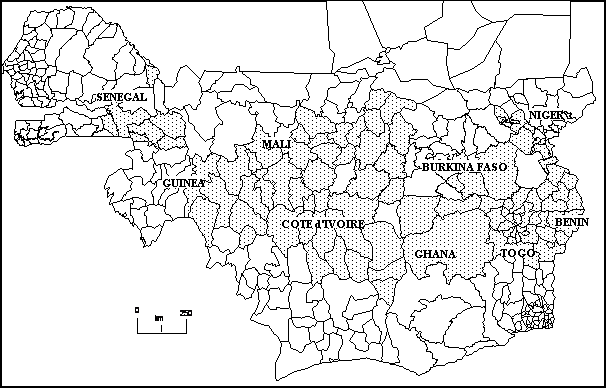
Onchocerciasis and population dynamics in Western AfricaContextMost of the rural areas of Sub-Saharan Africa are currently registering the highest population growth in their history. At the same time, migrations have increased and diversified. Such population dynamics lead to changes in the way labour is used and farmland exploited. It is crucial to understand these dynamics and to support the mechanisms which would make it possible to control them in order to achieve the sustainable development of the rural areas. The onchocerciasis-freed zones in West Africa are a good example of this type of problem since they are not yet densely populated. They are experiencing high immigration flows of populations using different farming techniques. Rather than just taking into account the immigrants, it is the population dynamics of these rural areas as a whole which should be taken into account for the sub-region as a whole in order to identify the conditions in which populations can be stabilized and sustainable agriculture developed. Understanding the mechanisms behind the stabilization process and defining the policy measures to be implemented in order to obtain such an outcome require a detailed spatial approach in analyzing the demographic processes. The study "Population Dynamics in Onchocerciasis-freed Rural Zones and Sustainable Development", coordinated by CICRED was designed with this purpose in mind. ObjectivesThe objectives of the programme were threefold: · to assess and evaluate available demographic data on the zones in the Onchocerciasis Control Programme (OCP); · to evaluate the population dynamics of these zones; · to assess their economic potential. The main objective of this synthesis is to study the population dynamics which for almost 25 years now have concurred in globally transforming the area under study and to highlight the population mechanisms involved which must be taken into account in formulating strategies for the development of the 25 million hectares of arable land it includes. This transnational approach is crucial since it makes it possible to assess current demo-economic changes, to reintroduce population dynamics within a sub-regional context and to verify the hypothesis by which the study area as a space undergoing permanent resettlement requires a specific development plan and the implementation of initiatives promoting viable economic programmes aimed at stabilizing the population. Since one of the premises of the study was that the settlement of populations is only beneficial for sustainable development if carried out in an area benefiting from economic growth, a methodology was adopted embracing the geo-physical and geo-economic context on the one hand and population dynamics on the other, so as to distinguish which factors were favourable to development based on population.
Map 1: Limits of the Reference Zone of the Study
National research teams(see separate web page)
OrganisationThis CICRED research programme was funded by the FAO in Rome and conducted by André Quesnel (IRD). Several national population institutions participated in field and data analysis operations in 1995-96 and prepared the national reports from which a synthesis volume was published in 1999 by CICRED in both French and English.
PublicationsFINAL REPORTSDynamique de peuplement des zones rurales libérées de l’onchocercose en Afrique de l’Ouest. Synthèse des monographies nationales, Vignikin K., Zanou B., N’Guessan K., (eds.), Quesnel A., (coord.), Paris, CICRED, FAO, 1999, 125 p. NATIONAL REPORTSBENIN Klissou P., Guingnido G. and Laourou M. (1996) - La dynamique de peuplement des zones libérées de l’onchocercose au Bénin, 55 p. xerox. BURKINA FASO Guiella G. and Baya B. (1996) - Peuplement et développement des zones rurales libérées de l’onchocercose au Burkina Faso, 39 p. xerox. CÔTE D’IVOIRE Aka D., Touré L. and Zanou B. (1995) - Dynamique de peuplement des zones libérées de l’onchocercose en Côte d’Ivoire, 54 p. xerox. GHANA Tawiah E. (1995) - "A status report on oncho-freed zone population in Ghana", 47 p. xerox. GUINEA Kéita L. and Bah M. (1995) - La dynamique de peuplement des zones rurales libérées de l’onchocercose en Guinée, 29 p. xerox. MALI Diara S. (1996) - Projet “ Peuplement et développement des zones rurales libérées de l’onchocercose ” : cas du Mali, 38 p. xerox. NIGER Béidou A. and Soumaïla B. (1996) - La dynamique de peuplement des zones libérées de l’onchocercose au Niger, 80 p. xerox. SENEGAL Gaye A. (1996) - Étude du peuplement et du développement des zones libérées de l’onchocercose : le cas du Sénégal, 44 p. xerox. TOGO Kouwonou K. and Vignikin K. (1995) - Étude du peuplement des zones libérées de l’onchocercose au Togo, 59 p. xerox.
|
• Home • About Us • Seminars • Research • Databases • Publications • Support • Login •
CICRED. 133, Bd Davout. 75980 Paris Cedex 20 - France. Tel: 33 1 56 06 20 19. Fax: 33 1 56 06 21 65. E-mail: |
Last update: 7/08/06
